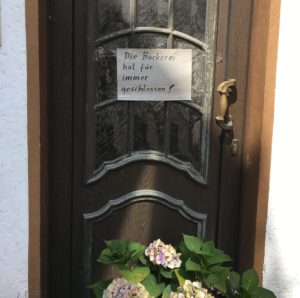
The sight of the tiny village of Henneberg (population 613) in the light of the setting sun was lovely – a reward for the double distance I had covered that day. A bit like a Vermont scene, I thought, the way it sat there nestled between fields and pastures against a wooded hillside. But this was Germany, of course, and the realization that there were places like this here, too, gave me an extra thrill. As did the “Bäckerei” sign I spotted the next morning a few houses down from the old forestry house. There was no shop window displaying baked goods, but I decided to take a closer look and stepped through the open wrought-iron gate into a small bricked courtyard. No cars, no bikes, no people, no smell of freshly-baked goods – not a good sign. This was breakfast time, and the main purpose of a bakery is to provide Brötchen (breakfast rolls), made fresh each morning. My eyes finally landed on a hand-written sign attached to a door on the part of the building facing the street: “Die Bäckerei ist für immer geschlossen” – the bakery was not just closed today, but für immer – literally forever.
This was tough news (Bäckereien are very important on a bike expedition, as you might imagine) but fortunately I had been able to make tea in the ramshackle kitchen of the old forestry house, and still had some provisions to get me through the day. Much tougher for the Hennebergers, who apparently had to drive the 12 km to Meiningen for their breakfast rolls – and for everything else they didn’t happen to grow in their own gardens. I had already learned from Gabriele, the owner of the old forestry house, that there was no more grocery store in Henneberg either – she had been kind enough to pick up a bottle of beer and some cheese for me when she went shopping the previous night.
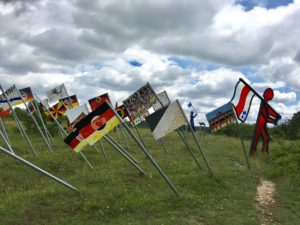
So, onward to the German Unity Sculpture Park, which lay just a few kilometers down the country road right in the former border strip. I had seen it mentioned in my guidebook and had been intrigued. It had been inaugurated in 1996 based on the ideas and work of the artist and engineer Herbert “Jimmy” Fell.
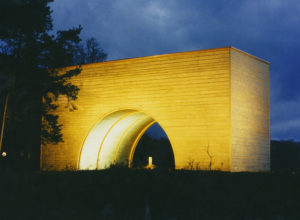
The largest of the sculptures was the “Golden Bridge” – a squat, wooden structure that had been placed exactly over the line that once divided East and
West Germany. Even more compelling than the structure itself, though, were the tributes and contemplations people had attached to the inside surface. Many referred to the peaceful protests in East German cities in the fall of 1989 (symbolized by the one in Leipzig on October 9). Some of the images reminded me of medieval church icons; some were hand-scribbled notes.

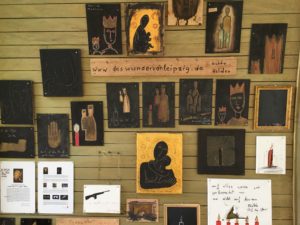
One hand-written note said “Thank you that I did not have to shoot” – I guessed that it was either from a former East German border guard or from an NVA soldier stationed at the protests – and “No Chinese solution”, referring to the massacre at Tiananmen Square, when the Chinese army was called in to shoot at peaceful protesters in the summer of 1989, just a few months before the big protest in Leipzig.
This, to me, is the thing I hope we will never forget: That what happened in the fall of 1989 was a peaceful revolution. No matter what misgivings are still smoldering about things that did not go perfectly in the process of reunification, this is something that went really well and that we can all be thankful for.
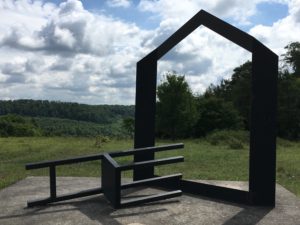
As I wandered around among the other sculptures, I realized how deeply and broadly the artist had thought about – and probably lived through – the effects of the German division. A sculpture named “Expulsion” consisted of a steel frame outlining the basic shape of a house, with a toppled-over chair lying outside it. The artist’s notes explained that this sculpture symbolizes not only the expulsions along the former border (see also this earlier posting about phantom villages), but expulsions everywhere: Of the Huguenots from France, Germans from Poland, Jews from just about everywhere, and ultimately, the expulsion of humans from paradise – the “ur” meaning of Heimat (home/homeland/place of belonging). Another nearby sculpture had the following words cut out of steel plates:
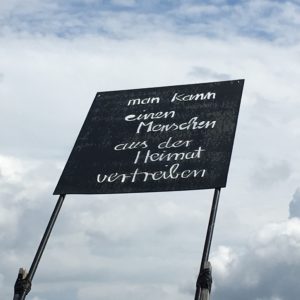

I loved the contemplative nature of this place, but after all of this food for thought, I felt that some bodily nourishment was in order. Knowing that the Henneberg bakery would not be open (ever again), I turned my bike toward Bauerbach.

I like this post very much. It’s a reminder that art is perhaps the best language we have to express individual sense-making of experience. Each expression tells a piece of truth that benefits our collective understanding.
Yes! Thank you for saying that so clearly and eloquently.
[…] Bridge of Unity” – incredibly powerful (you can read my reflections from my visit here ). They reminded me that art can help us make meaning out of things in a way words sometimes […]